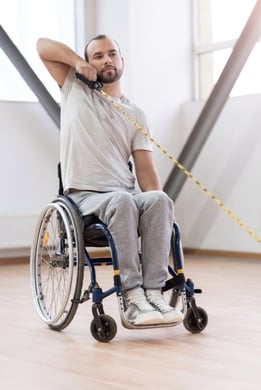The Importance of Stretching for Wheelchair Users
 Movement is what the human body was made for. After a spinal cord injury (SCI), however, movement comes at a premium. When the body suddenly stops moving, the joints and muscles become dangerously stiff, even leading to contractures. But this also can be prevented with proper, regular stretching, which is important to your spinal cord injury rehabilitation.
Movement is what the human body was made for. After a spinal cord injury (SCI), however, movement comes at a premium. When the body suddenly stops moving, the joints and muscles become dangerously stiff, even leading to contractures. But this also can be prevented with proper, regular stretching, which is important to your spinal cord injury rehabilitation.
The thing is, there are a lot of things to worry about after a spinal cord injury and many may seem more important than stretching. However, when the very vehicle in which you exists becomes more and more constricted, the limitations you'll begin to feel will become unbearable. Stretching, which increases your range of motion when done on a regular basis, is the one thing but that can help to fix this.
There are two different ways you can stretch: With the aid of another person or by yourself. Passive stretching is when a physical or occupational therapist stretches you or a personal caregiver. Many people will even recruit family and friends to help them. Or you can self-stretch the parts of your body that you can reach on your own. There are several websites that outline all of the stretches for quadriplegics and paraplegics. Discover which stretches you should be doing for your individual injury level and check out some self-directed stretches for wheelchair users (as demonstrated by a paraplegic using common kitchen items).
No matter whether you’re stretching yourself or if someone else is helping, you should repeat every stretch at least twice. Many people will repeat a stretch 5-10 times, but simply do what you have time for each day. Also, try to stretch in the morning before getting out of bed and again at night before sleeping. We know it can be hard to fit in one stretch session, let alone two in a day, but the results are incredible when you compare two people with spinal cord injuries side by side who have or have not stretched over the years.
Are you intrigued yet? Read on for the top reasons you should be stretching every day after a spinal cord injury.
1. Stretching Feels Good
Regardless of anything else, stretching simply feels good, and after a spinal cord injury, that feeling can be a rarity. Years after spinal cord injury, the good feeling that comes with stretching your body cannot be matched. It's a lot like yoga in many respects. The energy you release from doing certain stretches can energize you and help you feel more alive.
2. Stretching Reduces Spasticity
Spasticity is a fact of life after a spinal cord injury. It can happen out of the blue and disrupt whatever you're doing, even causing some to fall out of their wheelchair. Stretching on a regular basis can prevent spasms in a big way. While it cannot prevent them completely, it is absolutely required to do daily if you want to keep your spasms at a minimum.
3. Stretching Helps with Posture
Scoliosis is a side-effect of having an SCI. When you can no longer move your torso muscles, your posture becomes severely affected. Stretching on a regular basis in the back area, especially doing side-stretches from your wheelchair, can help a lot with posture. Muscles pulling here or there may not do a lot to an able-bodied person, but when someone is paralyzed, tight muscles can easily impact balance and, therefore, your posture as well.
4. Stretching Helps You to Remain Independent
When you have limited muscle movement, it’s key to keep the muscles you can move limber so that you can keep doing everything you're able to do. If you allow the muscles in your arms to become tight, for example, you'll notice certain activities will become more difficult. Your legs also should be stretched as well, but for other reasons we will explain below.
5. Stretching Reduces Swelling (in Lower Extremities)
It’s incredibly important to stretch your lower limbs, ankles, and toes at least twice a day. When larger limbs are not moving, it impacts your blood circulation and can lead to swelling in your legs (this is particularly noticeable in the ankles and feet). Not only is this cosmetically unwanted, it also can cause skin problems when it comes to wearing shoes, even requiring you wear larger sizes due to swelling. This is known as edema, but regular stretching can prevent it.
Don't break your habit of doing stretches on a regular basis, even if it may seem reasonable in the moment. Those who don’t stretch on a regular basis have seen serious side effects, such as legs no longer straightening out in front of them. Stretching is guaranteed to be one of the most amazing things we can do for our bodies on a regular basis after sustaining a traumatic spinal cord injury.
Stay Updated on Advancements On Traumatic Brain &
Spinal Cord Injuries
About the Author





